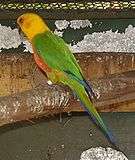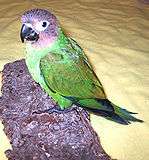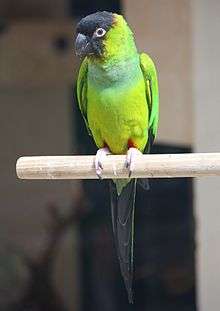Aratinga
| Aratinga | |
|---|---|
 | |
| Aratinga solstitialis | |
| Scientific classification | |
| Kingdom: | Animalia |
| Phylum: | Chordata |
| Class: | Aves |
| Order: | Psittaciformes |
| Superfamily: | Psittacoidea |
| Family: | Psittacidae |
| Subfamily: | Arinae |
| Tribe: | Arini |
| Genus: | Aratinga Spix, 1824 |
| Species | |
|
Aratinga solstitialis | |
Aratinga is a genus of South American conures. Most are predominantly green, although a few are predominantly yellow or orange. They are social and commonly seen in groups in the wild. In Brazil the popular name of several species usually is Jandaia, sometimes written as Jandaya in the scientific form.
Many species from this genus are popular pets, although being larger than the members of the genus Pyrrhura, they need a sizable aviary to thrive.
The taxonomy of this genus has recently been resolved by splitting it in four genera as the genus as previously defined was paraphyletic.[1][2][3][4][5] The species of the Aratinga solstitialis complex,[2][3] were retained in this genus, while other former Aratinga species were moved to Eupsittula (brownish-throated species), Psittacara (pale-beaked species) and Thectocercus (blue-crowned parakeet).[1] Furthermore, the closely related nanday parakeet (Aratinga nenday) and the dusky-headed parakeet (Aratinga weddellii) are placed in this genus. The nanday parakeet was previously placed in its own genus based on the differences in coloration and elongated upper mandible, but this was not supported by phylogenetic studies that showed a close relationship with the solitarius complex species.[1]
Species
| Aratinga | |||
|---|---|---|---|
| Common and binomial names[6] | Image | Description | Range |
| Sun parakeet or sun conure (Aratinga solstitialis) |
 |
30 cm (11 in) long. Mostly yellow, fading to orange over the head and belly. Yellow and green in the wing and tail feathers. Black beak. | South America[7][8] |
| Sulphur-breasted parakeet (Aratinga maculata) |
Brazil and Suriname.[9][10] | ||
| Jandaya parakeet or jenday conure (Aratinga jandaya) |
 |
Orange and yellow with green wings and back. Black beak. | Brazil[11][12] |
| Golden-capped parakeet (Aratinga auricapillus) |
30 (12 in) long. Mostly green. Black beak. Orange-red belly, red face fading to yellow over the crown.[13] | Brazil[14] | |
| Dusky-headed parakeet Weddell's conure or dusky-headed conure (Aratinga weddellii) |
 |
25–28 cm (10–11 in). Mostly green. Black beak. A grey-brown head, a blue-tipped tail and remiges. | Bolivia, Brazil, Colombia, Ecuador, and Peru[15][16] |
| Nanday parakeet (Aratinga nenday) |
 |
Mostly green. Black facial mask and beak. Black trailing flight feathers on wings and long tail edged at the end in blue. Upper chest is bluish-green and lower chest is a paler green. Feathers covering the thighs red.
. |
southeast Bolivia to southwest Brazil, central Paraguay and northern Argentina.[17][18] |
| Aratinga vorohuensis |
extinct. Described from Late Pliocene fossils found in Argentina.[19] | ||
Hypothetical extinct species
Jean-Baptiste Labat described a population of small parrots living on Guadeloupe, which have been postulated to be a separate species based on little evidence. They were called Conurus labati, and are now referred to as the Guadeloupe parakeet (Aratinga labati). There are no specimens or remains of the extinct parrots. Their taxonomy may never be fully elucidated, and so their postulated status as a separate species is hypothetical, and it is regarded as a hypothetical extinct species.[20]
References
| Wikispecies has information related to: Aratinga |
- 1 2 3 Remsen, Jr., J.V.; Schirtzinger, E.E.; Ferraroni, Anna; Silveira, Luís Fábio; & Wright, Timothy F. (24 April 2013). DNA-sequence data require revision of the parrot genus Aratinga (Aves: Psittacidae). Zootaxa 3641(3) 296–300. {{doi: 10.11646/zootaxa.3641.3.9}}
- 1 2 Ribas, Camila C.; Miyaki, Cristina Y. (2004). "Molecular systematics in Aratinga parakeets: species limits and historical biogeography in the 'solstitialis' group, and the systematic position of Nandayus nenday". Molecular Phylogenetics and Evolution. 30 (3): 663–75. doi:10.1016/S1055-7903(03)00223-9. PMID 15012946.
- 1 2 Silverira, L.; Höfling, E. (2005). "A new species of Aratinga Parakeet (Psittaformes: Psittacidae) from Brazil, with taxonomical remarks on the Aratinga solstitialis complex.". The Auk. 122 (1): 292–305.
- ↑ Tavares ES; Baker AJ; Pereira SL; Miyaki CY (2006). "Phylogenetic relationships and historical biogeography of Neotropical parrots (Psittaciformes : Psittacidae : Arini) inferred from mitochondrial and nuclear DNA sequences". Systematic Biology. 55 (3): 454–470. doi:10.1080/10635150600697390. PMID 16861209.
- ↑ Collar, N.J. (1997). J. del Hoyo; A. Elliot; J. Sargatal, eds. Family Psittacidae. Handbook of the Birds of the World. 4. Barcelona, Spain: Lynx Edicions. pp. 280–479.
- ↑ "Zoological Nomenclature Resource: Psittaciformes (Version 9.013)". www.zoonomen.net. 2008-12-29.
- ↑ "Sun Parakeet - BirdLife Species Factsheet". BirdLife International (2008). Retrieved 3 January 2009.
- ↑ BirdLife International 2008. Aratinga solstitialis. 2008 IUCN Red List of Threatened Species. Archived June 27, 2014, at the Wayback Machine.
- ↑ "Sulphur-breasted Parakeet - BirdLife Species Factsheet". BirdLife International (2008). Retrieved 28 August 2016.
- ↑ BirdLife International 2008. Aratinga maculata. 2008 IUCN Red List of Threatened Species. Archived June 27, 2014, at the Wayback Machine.
- ↑ "Jandaya Parakeet - BirdLife Species Factsheet". BirdLife International (2008). Retrieved 3 January 2009.
- ↑ BirdLife International 2008. Aratinga jandaya. 2008 IUCN Red List of Threatened Species. Archived June 27, 2014, at the Wayback Machine.
- ↑ "Golden-capped Parakeet - BirdLife Species Factsheet". BirdLife International (2008). Retrieved 3 January 2009.
- ↑ BirdLife International 2008. Aratinga auricapillus. 2008 IUCN Red List of Threatened Species. Archived June 27, 2014, at the Wayback Machine.
- ↑ "Dusky-headed Parakeet - BirdLife Species Factsheet". BirdLife International (2008). Retrieved 3 January 2009.
- ↑ BirdLife International 2008. Aratinga weddellii. 2008 IUCN Red List of Threatened Species. Archived June 27, 2014, at the Wayback Machine.
- ↑ "Nanday Parakeet - BirdLife Species Factsheet". BirdLife International (2008). Retrieved 28 August 2016.
- ↑ BirdLife International 2008. Aratinga nenday. 2008 IUCN Red List of Threatened Species. Archived June 27, 2014, at the Wayback Machine.
- ↑ Eduardo P. Tonni & Jorge I. Noriega (1996). "Una nueva especia de Nandayus Bonaparte, 1854 (Aves: Psittaciformes) del Pliocene tardío de Argentina" [A new species of Nandayus Bonaparte (Aves: Psittaciformes) from the Late Pliocene of Argentina] (PDF). Revista Chilena de Historia Natural (in Spanish). 69: 97–104.
- ↑ Fuller, Errol (1987). Extinct Birds. Penguin Books (England). p. 131. ISBN 0-670-81787-2.